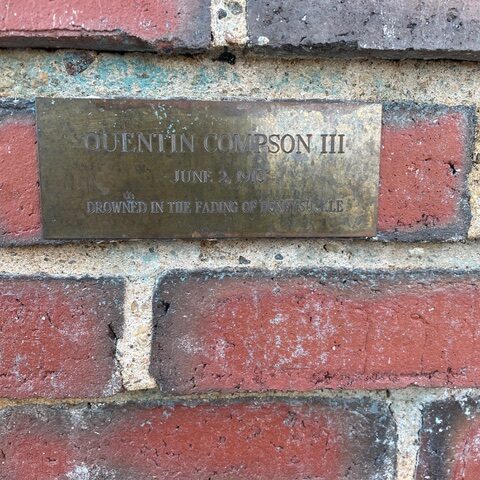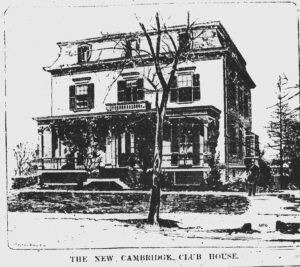
The Mystery Plaque
By Edward Tabor, 2024
My parents were visiting me at Harvard College on October 16, 1965, a day when I was scheduled to row in a major boat race. It was the first occurrence of Boston’s now-famous “Head of the Charles” race. They stood on Anderson Bridge to watch my boat leave Newell Boathouse and head downriver.
When I returned from the race, my father showed me a small brass plaque on the bridge near where they were standing and asked if I knew what it was. I had never noticed it before, even though I had walked back and forth over that bridge twice every day while walking to and from rowing practice. It was easy to miss because it was near the sidewalk in an indented parapet. In addition, it was tarnished, was almost the size of a brick, and had a few strands of ivy hanging over it.
The engraving on the plaque said:
Quentin Compson III
June 2, 1910
Drowned in the Fading of Honeysuckle
Although I had never seen the plaque before, I knew who Quentin Compson was. He was the fictional Harvard freshman in two of William Faulkner’s novels, The Sound and the Fury and Absalom, Absalom! who died by suicide by jumping into the Charles River with flat irons tied to his feet.
There are rare masterworks of fiction that are so realistic or so moving that you wonder if the story they are telling is true. Seeing this plaque made me wonder if Quentin Compson’s suicide, which already seemed realistic, had been based on a true event. It caused me to go to look at archived issues of The Harvard Crimson from June 1910 to see if a suicide had been reported that month. I didn’t find a report of a suicide, because the event was entirely fictional. It turns out that I was not the only person who felt that Quentin Compson’s death seemed real. A Washington Post writer, Dale Russakoff, later wrote that Quentin Compson’s “anguish is so personal and haunting that generations of readers have come to regard him as someone real.”
Quentin Compson represented universal truths: the struggle of a young man with the ambiguities of the society he was born into, in this case in post-Civil War Mississippi; the struggle to accept that an earlier “Golden Age” may never have really existed; and the struggle to reconcile good and beauty with coexisting evil. When Faulkner died in 1962, his obituary in The Harvard Crimson said: “Quentin … doubtless reflects some attributes of the archetypal Harvard student. … But Quentin’s dilemmas, Faulkner would insist, are not the dilemmas of the Harvard student, or even of the Southern student at Harvard. They are rather the ‘old verities and truths of the heart.’ ”
In the weeks that followed, I made some inquiries about the plaque. None of my friends had seen it, nor had a few English instructors whom I asked. I took my English seminar group to see the plaque, and the instructor commented, “It’s life imitating art.” He was referring to the saying, “Life imitates art far more than art imitates life.” His quip was certainly appropriate, if one considers that the plaque (life) was imitating the novels (art).
In the novels, Quentin Compson entered Harvard in the fall of 1909, in the Harvard College class of 1913. Many graduates in that class would later serve in World War I and some would die on the battlefields in Europe. In this fictional world, time moved on without Quentin after his suicide in 1910, and the passage of time is one of Faulkner’s themes here. Before Quentin left home to go to Harvard, his father gave him his grandfather’s watch. Just before his suicide, he smashed the watch crystal (injuring himself) and removed the hands, but he noticed that the watch still went on ticking in his pocket though it would no longer tell him the time. He left a suicide note with the dismembered watch, smashed and bloody, in his Harvard room.
The plaque’s inscription referred to “honeysuckle” because honeysuckle is a strong image in The Sound and the Fury; in some sections of the book, the word appears on almost every page. Faulkner mentions “a voice weeping steadily and softly beyond the twilit door the twilight-colored smell of honeysuckle,” that “the air seemed to drizzle with honeysuckle;” in Boston, Quentin noted the absence of honeysuckle, thinking, “honeysuckle was the saddest odor of all.”
Faulkner did not specify which bridge Quentin jumped off. Readers have assumed it was Anderson Bridge, which is the most prominent bridge at Harvard. It was built by Larz Anderson, a famous American diplomat, as a memorial to his father, Nicholas Longworth Anderson, a Civil War general. However, the construction of Anderson Bridge was not completed until 1915, so if Quentin Compson jumped off a bridge at Harvard it would most likely have been Great Bridge, which was located at that spot before Anderson Bridge.
For years after I noticed the plaque, it remained relatively unknown, and knowledge of it spread mainly by word-of-mouth. One American literature instructor, Kevin Starr, told his class about it in 1972 and mentioned that no one knew the plaque’s origins. It was in Starr’s class that the writer Russakoff learned about the plaque. Russakoff later described it as “a tarnished brass plaque … obviously was meant to be secret, so tiny and so obscured by vines and shadows that I had walked past it countless times without noticing.”
The mystery remained: Who put the plaque there? Russakoff became the key to solving the mystery. Russakoff had told her mother, who lived in Birmingham, Alabama, about the mystery of the plaque. Her mother knew that their minister, Stanley Stefancic, had attended Harvard Divinity School and she told him about the plaque. To her surprise, Stefancic revealed that he himself had attached the plaque to the bridge using epoxy glue on June 2, 1965, the 55th anniversary of the suicide. He was helped by his wife, Jean, and his friend Tom Sugimoto, an MIT graduate student in physics. All three were non-Southerners who admired Faulkner’s writing. They had hoped that an air of mystery would be associated with the plaque, and that only those who loved Faulkner’s writing would discover the plaque and appreciate it. It appears that they succeeded.
An air of mystery continued to attach to the plaque. The plaque disappeared in 1983 during the 1978-1983 renovation of the bridge. Perhaps it fell into the waters of the Charles River, just as Quentin Compson had. The disappearance of the plaque was reported on television station WGBH on June 2, 1983, the 73rd anniversary of the suicide, and a few weeks later a replacement plaque appeared mysteriously and anonymously after dark, attached at the same spot where the original plaque had been.
However, the new plaque was made of cheaper metal and the wording had been changed to:
Quentin Compson
Drowned in the odour of honeysuckle
1891-1910
This change was highly controversial, and most observers objected to it. “Fading” had become “odour,” often a more negative word, and it implied that Quentin was tormented by the smell of honeysuckle. Actually, Quentin missed the odor of honeysuckle, saying that the North had “the odor of summer and darkness except honeysuckle,” which he missed, even though “honeysuckle was the saddest odor of all, I think.” The poetry of the original inscription was gone; gone was the notion of a beautiful memory “fading,” of something being lost, slowly and (because it was a suicide) irreversibly. It symbolized, in addition to the fading and loss of a memory, the fading and loss of youth. On the new plaque, the Roman numeral in Quentin’s name was gone, making it less “real” somehow; and the dates of Quentin’s life (1891-1910) had been added.
The mystery grew again; in 2014 the plaque again vanished during the 2012-2016 renovation of the bridge. Two years later, that second plaque was found (it had been found in the dirt in 2014 and then was forgotten for two years in a drawer). A new plaque (the third iteration, this time in brass), was created and attached by the Massachusetts Department of Transportation in 2017, with wording identical to the original plaque,
Quentin Compson III
June 2, 1910
Drowned in the Fading of Honeysuckle
Unlike the first two versions of the plaque, which had been mounted on the inside of the bridge wall, this third version was placed on the outside of the bridge. If you go to look for it, you can find it on the downstream side of the bridge, on the abutment at the Cambridge end of the bridge, ten rows of bricks above the granite base. Since this version was put there by the Massachusetts Department of Transportation, perhaps it will remain there indefinitely for the fascination of readers of Faulkner for many years to come.

Sources
- Baglione, J. M. “Bridge of sorrow, by way of Faulkner.” The Harvard Gazette, July 20, 2017.
- Crinkley, R. “William Faulkner: The Southern mind meets Harvard in the era before World War I. [Obituary] The Harvard Crimson, July 12, 1962. Viewed at https://www.thecrimson.com/article/1962/7/12/william-faulkner-the-southern-mind-meets/.
- Houghteling, N. “Expos students embark on literary scavenger hunt.” The Harvard Crimson, May 6, 2004.
- Russakoff, D. “Faulkner and the bridge to the South.” The Washington Post, July 21, 1985.
- Siliezar, J. “In search of Quentin Compson.” The Harvard Gazette, June 27, 2019.



